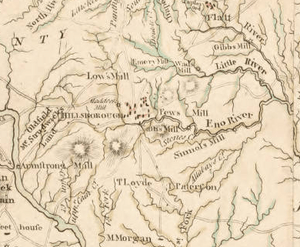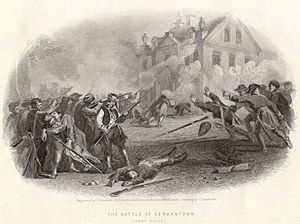Francis Nash facts for kids
Francis Nash (born around 1742 – died October 7, 1777) was a brave general in the Continental Army during the American Revolutionary War. Before the war, he was a lawyer and public official in Hillsborough, North Carolina. He was also involved in stopping the Regulator Movement, which was an uprising of settlers in North Carolina between 1765 and 1771.
Nash quickly joined the fight for American independence. He was a delegate to the first three Patriot meetings in North Carolina. In 1775, he became a lieutenant colonel of the 1st North Carolina Regiment. He served in the southern part of the Revolutionary War before being sent north.
Nash was promoted to brigadier general in 1777 after General James Moore died. He then took command of the North Carolina soldiers under General George Washington. He led his troops in the Philadelphia campaign. Sadly, he was badly wounded at the Battle of Germantown on October 4, 1777, and passed away a few days later. Francis Nash was one of ten American generals who died from battle wounds during the war. Many places are named after him, including Nashville, Tennessee, Nashville, North Carolina, and Nash County, North Carolina.
Quick facts for kids
Francis Nash
|
|
|---|---|
| Born | c. 1742 Prince Edward County, Virginia |
| Died | October 7, 1777 (aged 34-35) near Kulpsville, Pennsylvania |
| Buried |
Towamencin Mennonite Meetinghouse Cemetery, Towamencin Township, Pennsylvania
(40°14′55″N 75°20′50″W / 40.24864°N 75.34710°W) |
| Allegiance | Continental Congress United States of America |
| Service/ |
Continental Army |
| Years of service | 1771 1775–1777 |
| Rank | Brigadier general |
| Commands held |
|
| Battles/wars | War of the Regulation |
Contents
Early Life and Family History
Francis Nash was born around 1742 in Amelia County, Virginia. His parents, John and Ann Owen Nash, were originally from Wales. He had seven brothers and sisters. One of his brothers, Abner Nash, later became an important leader in North Carolina.
By 1763, Francis Nash moved to Hillsborough, North Carolina. He started working as a lawyer there. He also became a clerk of court, which was an important job. Francis and his brother owned a lot of land in the town. They also built a mill on the Eno River. From 1764 to 1765, he served in the North Carolina Assembly, representing Orange County.
In 1770, Nash married Sarah Moore. She was the daughter of a judge and niece of General James Moore. Francis and Sarah had two daughters: Ann, who died young, and Sarah. Their daughter Sarah later married John Waddell.
Fighting the Regulators and Early Politics
Francis Nash was interested in military matters. He trained with a retired English soldier in Hillsborough. He rose through the ranks of the Orange County militia, becoming its commanding colonel.
During the Regulator Movement, Nash tried to stop riots caused by the Regulators in 1768. However, his militia members supported the rioters and refused to follow his orders. Nash and some friends agreed to protect each other's property from the Regulators.
Regulator leaders tried to accuse Nash of wrongdoing, but the charges were dismissed. In September 1770, a group of Regulators took over Hillsborough. Nash and other officials had to flee for their safety. Nash later fought alongside Governor William Tryon at the Battle of Alamance against the Regulator militia.
Nash also served in the colonial Assembly from 1771 to 1775. In 1774, the Royal Governor tried to stop North Carolina from sending delegates to the first Continental Congress. In response, many members of the Assembly, including Nash, formed the North Carolina Provincial Congress. This group chose delegates for the Continental Congress. The Governor said this new Congress was illegal. Nash continued to support the Provincial Congress and the Continental Congress. The Royal government never called another Assembly meeting in North Carolina after April 1775.
American Revolutionary War Service
Southern Battles
In 1775, Nash was part of the Third North Carolina Provincial Congress. This group organized soldiers for the war. Later that year, Nash became a lieutenant colonel in the 1st North Carolina Regiment. This regiment officially joined the Continental Army in November.
Nash served under Colonel James Moore. He was involved in the events leading up to the Battle of Moore's Creek Bridge in February 1776. However, like Moore, he arrived after the battle was over. In April 1776, Nash was promoted to colonel. He took part in the mission to help Charleston in 1776. This led to the Battle of Sullivan's Island. Nash's unit guarded Fort Sullivan during this important battle.
Joining General Washington's Army
Nash and his regiment returned to North Carolina. They were supposed to join General George Washington's army in the north. But fears of British and Native American attacks in Georgia kept them in North Carolina.
On February 5, 1777, the Continental Congress promoted Nash to brigadier general. He was asked to recruit more soldiers from western North Carolina. However, he had to stop this task after James Moore died on April 15, 1777. Nash then took command of the North Carolina brigade.
Another North Carolina general, Robert Howe, was already a brigadier general. But Howe was in charge of the Southern Department and had to stay in South Carolina. So, Nash marched north to join Washington's army. He commanded all nine North Carolina Continental Army regiments at the Battle of Brandywine.
Battle of Germantown and His Death
After the British captured Philadelphia on September 26, 1777, Washington decided to attack them. This led to the Battle of Germantown on October 4. At first, Nash's North Carolina brigade was supposed to be in reserve. But Washington ordered Nash into the fight to protect his army's side.
Nash was leading his unit in a fighting retreat, slowly moving back to slow down the British. A cannonball hit him in the hip and also killed his horse. The same cannonball also killed Major James Witherspoon. Nash may have also been blinded by a musket ball that hit his head. Thomas Paine, who saw him, said Nash's wounds made him unrecognizable.
Washington's personal doctor, James Craik, treated Nash. But he could not stop the bleeding. Nash passed away from his wounds on October 7 at a home near Kulpsville, Pennsylvania. His last words were said to be, "From the first dawn of the Revolution I have been ever on the side of liberty and my country."
He was buried on October 9, 1777, in the Towamencin Mennonite Meetinghouse Cemetery in Towamencin Township, Pennsylvania. Many important officers, including General Washington, attended his funeral. Nash's friend, Alexander Martin, who later became Governor of North Carolina, wrote a poem to honor him.
General Nash's Legacy
Francis Nash was one of ten American generals who died during the Revolutionary War. After his death, in 1784, Congress gave his family a special land grant. This was to honor his service in the Continental Army.
Many places are named after him, including Nashville, Tennessee (which was first called "Fort Nashborough"), Nashville, North Carolina, the city of Nashville, Georgia, and Nash County, North Carolina. In 1906, a stone arch was built in his honor at Guilford Courthouse National Military Park, but it was taken down in 1937.
Nash's home in Hillsborough is now known as the Nash-Hooper House. It was bought by William Hooper, who signed the Declaration of Independence, after Nash died. In 1938, a historical marker was placed near the house to remember Nash's life. The Nash-Hooper House was named a National Historic Landmark in 1971. It is part of the Hillsborough Historic District.





